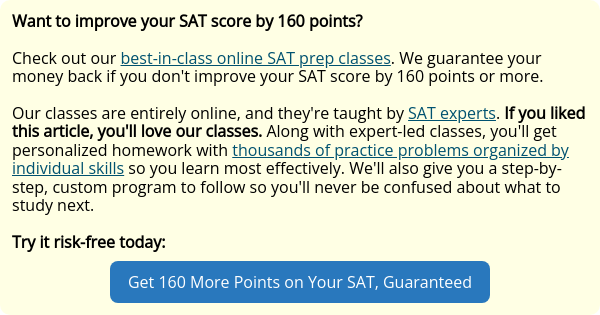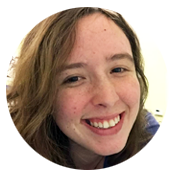
Studying for the SAT is a big undertaking, and you might not know where to start. A good way to get yourself into gear is to learn about the structure of the test and different ways you can adapt your strategy to improve on each section.
In this article, I’ll provide you with a comprehensive list of the top 22 tips (broken down by section) that you should be using to get your best scores ever on the digital SAT.
Overall Digital SAT Study Tips
Tip 1: Eliminate 3 Wrong Answers
The most important rule to remember for the SAT is that there is only one correct answer for each question, and you should be able to eliminate all the others. This means that your number one strategy on the test is process of elimination. If you're struggling with a question, try to find reasons to rule out most of the answers rather than reasons why certain options could work.
Learn to be extremely picky about which answers to eliminate. This especially applies to the Reading and Writing section. If a question seems subjective, keep reminding yourself that it’s an illusion. All incorrect choices are incorrect for good reasons, and it’s your job to find those reasons until you narrow your answers down to one possibility.
Tip 2: Always Understand Your Mistakes
This is vital if you want to see dramatic improvements. If you take the time to understand each mistake you make on practice questions, why you made it, and what you will do to avoid it in the future, you’re virtually guaranteed a good score on the test.
Mistakes usually fall into one of four categories:
#1: Content weakness
#2: Time pressure
#3: Question comprehension issue
#4: Careless error
After you finish a practice test, catalog all the questions you answer incorrectly so you can work on detecting error patterns. Did you consistently answer a particular type of math question wrong (content weakness)? Did you keep missing the words “except” or “least” (careless error) in questions? Did you consistently miss questions at the end of sections (time pressure)?
Whatever your issues, you have to understand them completely so you can fix the problems you’re having and see positive changes in your scores!
Tip 3: Know How to Use the Bluebook App
With the new digital SAT, you'll now be taking 100% of the exam on a computer using Bluebook testing software.
When you register, you can choose to take the SAT on a testing center computer or bring a laptop or tablet that you own or that you’ve borrowed from your school, family, or friends. If you’re bringing your own device, it must be able to connect to Wi-Fi. It must also be running approved operating systems and have a certain amount of free space available; you can review the specifications for individual devices here.
Whichever option you choose, make sure you've downloaded the Bluebook app and know how to navigate it. It isn't tricky to learn, but having some familiarity with it before test day will go a long way to helping you feel confident. Key things to learn include how to mark an answer to a question, move to the next question, and go back to check your work.
Tip 4: Practice With Digital Tests
Beyond just knowing how to use the Bluebook app, it's important to take at least one full-length digital SAT with the software (and ideally more than one!). There are six practice SATs available on Bluebook that you can access for FREE!
These are an amazing resource as they're made by the College Board, who designs the actual SAT. They're the closest experience you can get to taking an actual SAT. We have an entire guide on how to use official SAT practice tests, but to start, make sure you take each test timed, in one sitting, and space them out over your entire study period so you can track your progress.
Tip 5: Know the New Tools the Digital SAT Offers
The digital SAT has some useful new tools for students. One is the online notepad. In Bluebook, you won’t be able to mark up graphs, charts, or diagrams in the test. But the digital SAT features an online notepad if you tend to do scratch work when completing math problems. Alternatively, you can bring a pen or pencil, and the proctor will provide paper if requested.
In older digital versions of certain standardized tests, such as the GRE, test takers were required to answer one question at a time before moving forward; you could not return to earlier questions, even in the same section. On the digital SAT, however, you can move back and forth between questions as long as they are in the current module.
The new format also features a tool that allows you to mark questions that you want to return to:
<img src="https://360031.fs1.hubspotusercontent-na1.net/hubfs/360031/Bluebook%20Mark%20for%20Review-webp.webp" loading="lazy" style="margin-left: auto; margin-right: auto; display: block; width: 313px; height: auto; max-width: 100%;" "bluebook="" mark="" for="" review="" tool"="" width="313" height="277">
This can be a terrific time-saver: if you arrive at a prompt that’s challenging you, you can mark it, move on to other questions in the same module, and then return to those you flagged after you’ve finished the easier prompts.
You’ll notice that you can also strike through answer options you know are incorrect. So, if you read through a question and can eliminate even one or two of the four possibilities but can’t quite choose between the remaining choices, you can strike through the incorrect options, mark the question for review, and then come back to it later when you have more time to think through it.

The digital SAT format also features a timer at the top of your testing screen so you’ll know how much time is remaining in any given stage. No more waiting for a proctor to announce how much time you have left! If the clock causes you anxiety, you can choose to hide it. Whether on screen or hidden, you’ll be alerted when you have five minutes remaining on each module.
SAT Reading and Writing Tips
Tip 6: Pay Attention to Connotation and Context
This tip is critical for answering tough questions in the SAT Reading and Writing section. Look for words that indicate positive or negative connotation in the part of the passage that the question references. This can help you to eliminate at least a couple of choices even if you have no idea which of the remaining choices is correct.
Context is also very important! Don’t just look at the exact line that is referenced in the question—look at the sentences around it too. Look for contrast words such as “however”, “rather than” or “still”. You should also pay attention to strong adjectives that might help you to determine connotation.
 Positive or negative connotation—you decide. Also to whoever made this image: I think we know what thumbs up and thumbs down mean. The faces are overkill.
Positive or negative connotation—you decide. Also to whoever made this image: I think we know what thumbs up and thumbs down mean. The faces are overkill.
Tip 7: Read Passages Carefully
Even though passages on the digital SAT are much shorter than they used to be (25-150 words vs 500-700 words in the old version of the exam), the passages can still be tricky! You'll need to read carefully to make sure you're getting the overall meaning of the passage as well as the little details the SAT loves to test students on.
The best way to get really good at this is to practice, practice, practice. Run through a lot of Reading and Writing practice questions so you get used to seeing what passages on the digital SAT will be like and what kinds of questions you'll see.
Tip 8: Don’t Ignore Passage Introductions
At the beginning of certain passages on the SAT, there is a little blurb giving you a bit of context about the passage and its author. This introductory blurb contains valuable information, and if you skip it, you could miss out on easy points.
At the very least, passage introductions give you context for what you’re about to read so you aren't too confused about who’s who or where the passage is set.

By reading this intro, you'd learn this comes from the book The House of Mirth, which was written by Edith Wharton in 1905. Potentially very helpful information!
Tip 9: Get Interested in the Passages
If you want to retain information as you’re reading passages on the SAT, the best way to do it is to force yourself to engage with the material. Treat this as a learning experience, not a chore, and you’ll find it much easier to remember what happened in the passage. If your brain is in “wow, interesting” mode rather than “blah, blah, just have to get to the questions” mode, you’ll have a more pleasant experience on the test and a better time answering the questions overall.
Tip 10: Memorize Grammar Rules
The SAT Reading and Writing section has a specific standardized approach to grammar, so it’s useful to memorize the rules to reduce confusion. Even if you think you're pretty good at grammar, it’s not always enough to just go by what "looks right" to you.
If you’re not used to some of the more archaic grammar rules tested on the SAT, you should memorize them. This will prevent you from accidentally choosing NO CHANGE for phrases that have errors according to the SAT's formal grammar guidelines. Check out this article for a review of all the grammar rules you’ll see on the SAT!
Tip 11: Be Careful with NO CHANGE Answers
If you notice that you’re answering NO CHANGE for lots questions on the Reading and Writing section, you should go back and double-check your answers. NO CHANGE will only be the answer for 25 percent or less of the questions where it's an option. If you’re choosing it more than that, you might be missing something. Be sure to verify it again before you commit.
On the flip side, you also shouldn't be overly worried about choosing NO CHANGE. It will inevitably be the correct answer a few times, so don't get too caught up in second-guessing yourself.
Tip 12: If Both Answers Are Grammatically Correct, Pick the More Concise One
One of the skills the SAT tests is conciseness, or the use of as few words as necessary to convey meaning clearly. Being able to answer concision questions correctly requires knowing not just what the grammatically correct choice is, but which is the best grammatically correct choice.
This might be daunting, especially if you're not a native English speaker, so we recommend following this tip: if both answers are grammatically correct, choose the most concise one. Here's an example of a real SAT question with multiple grammatically correct answer choices:
One of the artist’s most famous images showed Tweed with a bag of money in place of his head.
A) NO CHANGE
B) famous and well-known
C) famous and commonly known
D) famous, commonly known
Answer choices A), B), and C) are all grammatically correct replacements for "famous" in the question sentence. So which one is correct? By following the rule of choosing the most concise answer, we can rule out B) and C) to arrive at the correct answer, A).
Note that the correct concise answer isn't always going to be the shortest (even though it was in this case); it's the shortest answer that preserves the meaning of the original sentence. In this case, "famous and well-known" and "famous and commonly-known" are both wordier and redundant ways of saying "famous," so there's no reason to change the sentence.
SAT Math Tips
Tip 13: Focus on Filling Content Gaps First
If you have problems with basic math skills, it doesn’t matter how many practice SAT questions you do—you’re going to have to fix those knowledge gaps before you can improve your SAT Math score.
If you notice you’re missing practice SAT Math questions because you are uncomfortable in a certain content area, work on your content weaknesses before you do anything else. This is the fastest way to improve your scores dramatically. You can go from here to fix other types of mistakes that are more surface-level (such as reading questions wrong or basic carelessness).
Tip 14: When Studying, Re-Solve Questions You Missed Before Looking at Answer Explanations
This is the best way to make sure you truly understand how to solve questions you initially messed up on the Math section. It’s one thing to read the answer explanation and say “oh, of course, that’s how you solve it," but it’s a completely different matter to work out the problem yourself.
The process will stick in your mind much better if you go through it, rather than if you just read about it. Look at what the correct answer choice should be and try to get there yourself before you read the explanation.
Tip 15: Write Down Key Parts of the Question
You should use this tip on the Math section if you've been missing questions by accidentally solving for the wrong value. Use your scratch paper to write down exactly what you need to find in the question so you don’t get confused during the calculation process.
Sometimes math questions ask you to solve for a value that necessitates solving for something else along the way. That something else will often be one of the incorrect answer choices (though this sort of tricky incorrect answer choice is less likely to show up on the new SAT). Many students accidentally pick the trick answer choice because they lose track of the value that they were originally supposed to find. You can avoid this by writing down relevant parts of the question to maintain your focus.
Tip 16: Don't Worry About Memorizing a Lot of Formulas
Some good news: you don't need to memorize a ton of formulas for SAT Math! For the entire Math section, you’ll be able to access a reference popout that includes formulas such as how to calculate the circumference or area of a circle, the hypotenuse of a right triangle, and the volume of cylinders and cones.
It's good to have some basic formulas memorized, like the area of a square, area of a circle, etc. to save time so you're not always referencing the formulas, but don't expend a ton of energy committing a lot of formulas to memory. Here's what the popout will look like:

Tip 17: Know How to Use the Desmos Onscreen Calculator
If you own and regularly use a personal handheld calculator, you’re allowed to bring it to the test if it’s an approved device. But built into the Bluebook testing application is a Desmos graphing calculator that you can use on the entire Math section. It allows you to graph lines and curves, plot points, locate x- and y-intercepts, and complete various other calculations.
If you’re planning to use the Desmos calculator, experiment with the device online and in practice tests to familiarize yourself with its various capabilities well before test day. The embedded onscreen device also includes updated accessibility features, such as compliance with screen readers and other assistive technologies, so you’ll want to test out those elements as well if you’ll be using them.

Tip 18: Don't Forget to Study Geometry and Trigonometry/h3>
Many students don't realize that SAT Math will always include some questions on both geometry and trigonometry. This is especially true for the digital SAT, which doubled the number of geometry and trig questions you'll see compared to the paper based test! Geometry and trig questions still make up a minority of SAT Math questions (about 15%), but that's still roughly 5-7 questions on these topics. If you want a top score, you'll need to know how to tackle these questions, so don't skip over them when you're studying. To help, here are some guides to get you started:
SAT Trigonometry: SOHCAHTOA and Radians
Solid Geometry on SAT Math
Triangles on SAT Math
SAT Test Day Tips
Tip 19: Get Ready the Night Before
On the morning of the test, you'll inevitably be nervous. There's a lot of stuff you need to bring to the SAT, and you don't want to forget something at the last minute while you're distracted by your nerves.
Here's a checklist to ensure that this doesn't happen:
- Admission ticket
- Photo ID
- #2 pencils and eraser
- Calculator (if not using the Desmos online calculator)
We also recommend that you bring snacks and water as well. Just put everything in your bag the day before. Don't procrastinate!
Tip 20: Skip Difficult Questions
This is a key tip if you struggle with time pressure on the SAT. If you're having trouble with a question, skip it and move on before you waste too much time. Lingering on hard questions could cost you easy points if it means you’re not getting to questions later in the section.
- For the Math section, don’t spend more than 70 seconds trying to figure out each question.
- For the Reading and Writing section, don’t spend more than 90 seconds.
Mark any questions that you skip so that they’re easier for you to pick out when you go back through the section. You might find that after you’ve answered the rest of the questions, you’ll feel less pressure and be able to think more clearly on questions that initially stumped you.
If you still can't figure out the answer, take a guess! The digital SAT has no guessing penalty, so it's always better to guess than to leave a question blank.
Tip 21: Double-Check Your Answers
While it's tempting to take a rest if you have extra time at the end of an SAT section, you should always double-check your answers first. When you initially make your way through each section, circle questions that you’re unsure about so you can double-check strategically.
If you have lots of extra time, you might even go through and check every single one of your answers. This way you’ll pick up on any careless mistakes you might have made if you were rushing or missed a key word in a question.
 Always double Czech.
Always double Czech.
Tip 22: Stay Calm
Above all, keep a cool head on the test. If you see a question you don’t understand, don’t let it psych you out. Just keep going. You might need to skip some questions at first, and that’s ok. Though there is a lot of pressure to finish each section on time, there's nothing wrong with doing the questions out of order. Look at each section with fresh eyes, and try not to dwell on what you might have gotten wrong earlier in the test.
Review
In this article, I've given you 22 of our best tips for success on the SAT. Here's a quick list for review:
Overall Study Tips
#1: Eliminate 3 Wrong Answers
#2: Always understand your mistakes
#3: Know how to use the Bluebook app
#4: Practice with digital tests
#5: Know the new tools the digital SAT offers
SAT Reading and Writing Tips
#6: Pay attention to connotation and context
#7: Read passages carefully
#8: Don't ignore passage introductions
#9: Get interested in the passages
#10: Memorize the grammar rules
#11: Be careful with "NO CHANGE" answers
#12: If both answers are grammatically correct, pick the more concise one
SAT Math Tips
#13: Focus on filling content gaps
#14: Re-solve questions you get wrong before looking at answer explanations
#15: Write down the key parts of questions
#16: Don't worry about memorizing a lot of formulas
#17: Know how to use the Desmos onscreen calculator
#18: Don't forget to study geometry and trigonometry
SAT Test Day Tips
#19: Get ready the night before
#20: Skip difficult questions
#21: Double-check your answers
#22: Stay calm
With these tips, you should be able to improve your performance on the SAT significantly. You should also pay attention to more in-depth strategies in your studying so that you can improve your content knowledge and feel more confident on the test!
What's Next?
For more strategies, take a look at our guides to getting a perfect SAT score on Reading and Writing, Math, and overall.
If you're trying to plan out your studying, read our complete plan for SAT studying and our guide to how long you should be studying for the SAT based on your goals.
What kinds of study materials do you need to study for the SAT? We break down what the best prep books are (and which books to avoid) in this expert guide.












